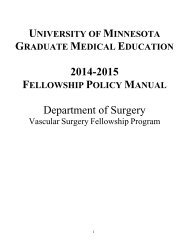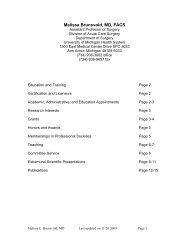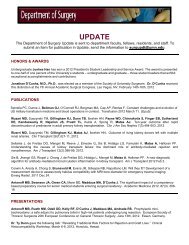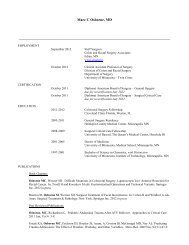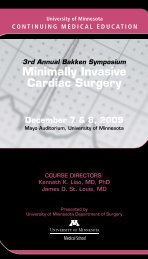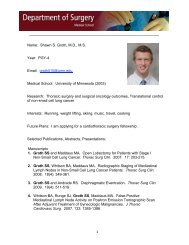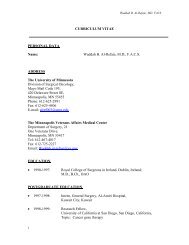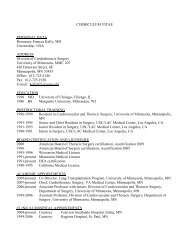Department of Medicine - Surgery - University of Minnesota
Department of Medicine - Surgery - University of Minnesota
Department of Medicine - Surgery - University of Minnesota
You also want an ePaper? Increase the reach of your titles
YUMPU automatically turns print PDFs into web optimized ePapers that Google loves.
Division <strong>of</strong> Genetics54Both King and Oetting haveregularly scheduled lecturesas part <strong>of</strong> the medicine residenteducational program,as well as institutional anddepartmental seminars.ResearchOne emphasis <strong>of</strong> research inthe Division <strong>of</strong> Genetics forboth King and Oetting hasbeen the genetic regulation <strong>of</strong>melanin biosynthesis in themodel system <strong>of</strong> human oculocutaneousalbinism. Clinical,biochemical, and molecularstudies have provided informationfor accurate definitionand classification <strong>of</strong>genetic disorders <strong>of</strong> humanpigmentation. ImportantFacultyPr<strong>of</strong>essorRichard A. King, M.D., Ph.D.Assistant Pr<strong>of</strong>essorWilliam S. Oetting, Ph.D.Faculty Honors andAwards for 2005Richard A. King, M.D., Ph.D.Editor-in-Chief for Genetics in<strong>Medicine</strong>, the <strong>of</strong>ficial journal <strong>of</strong> theAmerican College <strong>of</strong> Medical Genetics.William Oetting, Ph.D.Secretary/Treasurer,Human Genome Variation SocietyBoard Member, PanAmerican Societyfor Pigment Cell Research.genes involved in the synthesisand regulation <strong>of</strong> melaninsynthesis have been identified,cloned, and analyzed formutations responsible for loss<strong>of</strong> function. The molecularanalyses have led to the currentgene-based classification<strong>of</strong> oculocutaneous albinism(in comparison to the impreciseclinical classificationbased on pigmentation patterns),and this has aided infamily counseling and planning.Current work includesgenomic studies to investigatethe role <strong>of</strong> melanin formationon the development <strong>of</strong> theretina and optic nerves.A second major area <strong>of</strong>emphasis for the divisioninvolves gene mapping andlocalization for complexdiseases. A collaborativestudy between King, Oetting,and Malcolm Blumenthal,M.D. Division <strong>of</strong> Pulmonary,Allergy, and CriticalCare involves the mappingand identification <strong>of</strong> genesresponsible for components<strong>of</strong> the asthma phenotype.A major quantitative traitlocus (QTL) has been identifiedon chromosome 2 andgenetic and genomic studiesare underway to identify thegene and the associated singlegene polymorphism (SNP)in this region. A collaborativestudy between King andMarshall Hertz, M.D. Division<strong>of</strong> Pulmonary, Allergy, andCritical Care uses microarrayanalyses <strong>of</strong> peripheral bloodand bronchoalveolar lavagemacrophagesto identifygenes and genetic pathwaysinvolved in acute and chronicrejection. A gene expressionpr<strong>of</strong>ile has been identified inbronchioalveolar lavage cellsin patients undergoing acuterejection <strong>of</strong> the transplantedlung, and studies are underwayto correlate this expressionpr<strong>of</strong>ile with the standardbronchial biopsy approach topatient follow up.A collaborative projectbetween Dr. Oetting andArthur Matas, M.D. <strong>Department</strong><strong>of</strong> <strong>Surgery</strong>, involves theanalysis <strong>of</strong> gene polymorphismsin kidney transplantoutcomes to determine ifspecific alleles in candidategenes <strong>of</strong> both recipients anddonors alter the outcome <strong>of</strong>solid organ transplantation.A collaborative projectbetween Oetting and HassanIbrahim, M.D. <strong>Department</strong><strong>of</strong> <strong>Medicine</strong>, involves a proteomicapproach to studykidney transplant rejection.A major goal <strong>of</strong> this project isto identify biomarkers associatedwith different clinicalstates, but for predictive testingand to better understandthe biology <strong>of</strong> rejection.A collaborative study betweenKing and Russell Luepker,M.D., M.S. Epidemiology Division,School <strong>of</strong> Public Health,has identified mutations inLong QT syndrome genes inapproximately 11 percent <strong>of</strong>individuals who die suddenlyout-<strong>of</strong>-hospital with no obviousexplanation.Other collaborative projectsinclude a study betweenOetting and Matt McGue,Ph.D. in the <strong>Department</strong> <strong>of</strong>Psychology in the College<strong>of</strong> Liberal Arts to determinethe association <strong>of</strong> specificDNA variants with behaviorand studies with AngelaBirnbaum, Ph.D. and PamelaJacobson, Pharm.D. in theCollege <strong>of</strong> Pharmacy toprovide pharmacogeneticanalysis for anti-epilepticdrugs and immunosuppressantdrugs.The division is committed to providinghigh quality care to patients and familieswith genetic susceptibility and disease.




